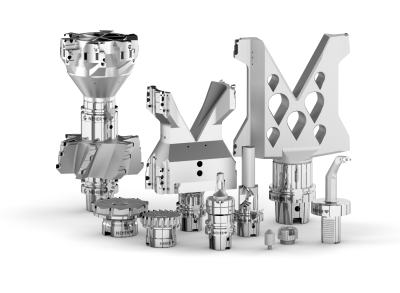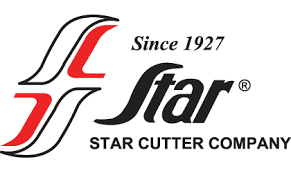
Star Cutter Company, in alliance with its strategic partner Neher Group, has announced the availability of 3D printed PCD monoblock tool bodies and chip deflectors where the 3D printed bodies are integrated with the holder interface to create a single robust tool. As compared to traditional manufacturing methods, additive manufacturing is more reliable in achieving designs with complex details and effective chip evacuation. This ability to optimize coolant hole and cooling channel locations can improve tool life by 30% or more and is well suited to the growing, and environmentally-friendly, MQL (minimum quantity lubrication) trend.
With 3D printing, there is about a 30% reduction in tool weight, yet it has the equivalent torsional stiffness of a steel ground body tool. Lightweighting can play a big role in large, heavy tools that take a toll on the machine spindle, helping to reduce preventative maintenance. These improvements can be significant when producing aerospace and automotive components, including electric vehicle parts, where existing spindle interfaces are not always ideal for some of the size/weight of tools.
Also available are 3D printed chip deflectors for applications that require total elimination of chips from the workpiece. These deflectors are mounted on the body of the tool so that when the tool is in the cut, the chip has no way to exit except through the flute channel.
The 3D printer technology is typically being applied to large reamers, interpolating and milling cutters. The company offers printing in a variety of materials including plastic, aluminum, titanium, steel and stainless. The Star Cutter engineering team works with all customers to provide the optimal tool design for each application.
Contact Details
Related Glossary Terms
- coolant
coolant
Fluid that reduces temperature buildup at the tool/workpiece interface during machining. Normally takes the form of a liquid such as soluble or chemical mixtures (semisynthetic, synthetic) but can be pressurized air or other gas. Because of water’s ability to absorb great quantities of heat, it is widely used as a coolant and vehicle for various cutting compounds, with the water-to-compound ratio varying with the machining task. See cutting fluid; semisynthetic cutting fluid; soluble-oil cutting fluid; synthetic cutting fluid.
- gang cutting ( milling)
gang cutting ( milling)
Machining with several cutters mounted on a single arbor, generally for simultaneous cutting.
- milling
milling
Machining operation in which metal or other material is removed by applying power to a rotating cutter. In vertical milling, the cutting tool is mounted vertically on the spindle. In horizontal milling, the cutting tool is mounted horizontally, either directly on the spindle or on an arbor. Horizontal milling is further broken down into conventional milling, where the cutter rotates opposite the direction of feed, or “up” into the workpiece; and climb milling, where the cutter rotates in the direction of feed, or “down” into the workpiece. Milling operations include plane or surface milling, endmilling, facemilling, angle milling, form milling and profiling.
- polycrystalline diamond ( PCD)
polycrystalline diamond ( PCD)
Cutting tool material consisting of natural or synthetic diamond crystals bonded together under high pressure at elevated temperatures. PCD is available as a tip brazed to a carbide insert carrier. Used for machining nonferrous alloys and nonmetallic materials at high cutting speeds.
- stiffness
stiffness
1. Ability of a material or part to resist elastic deflection. 2. The rate of stress with respect to strain; the greater the stress required to produce a given strain, the stiffer the material is said to be. See dynamic stiffness; static stiffness.

